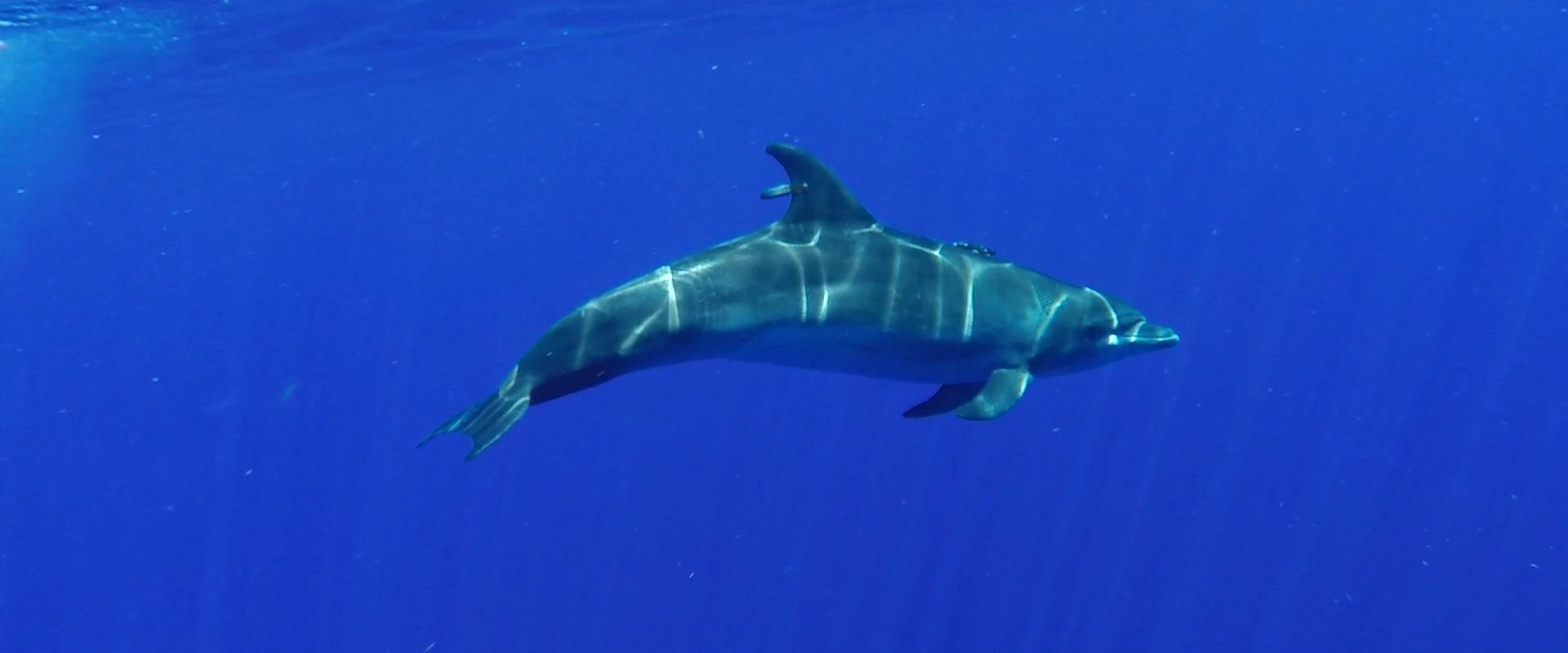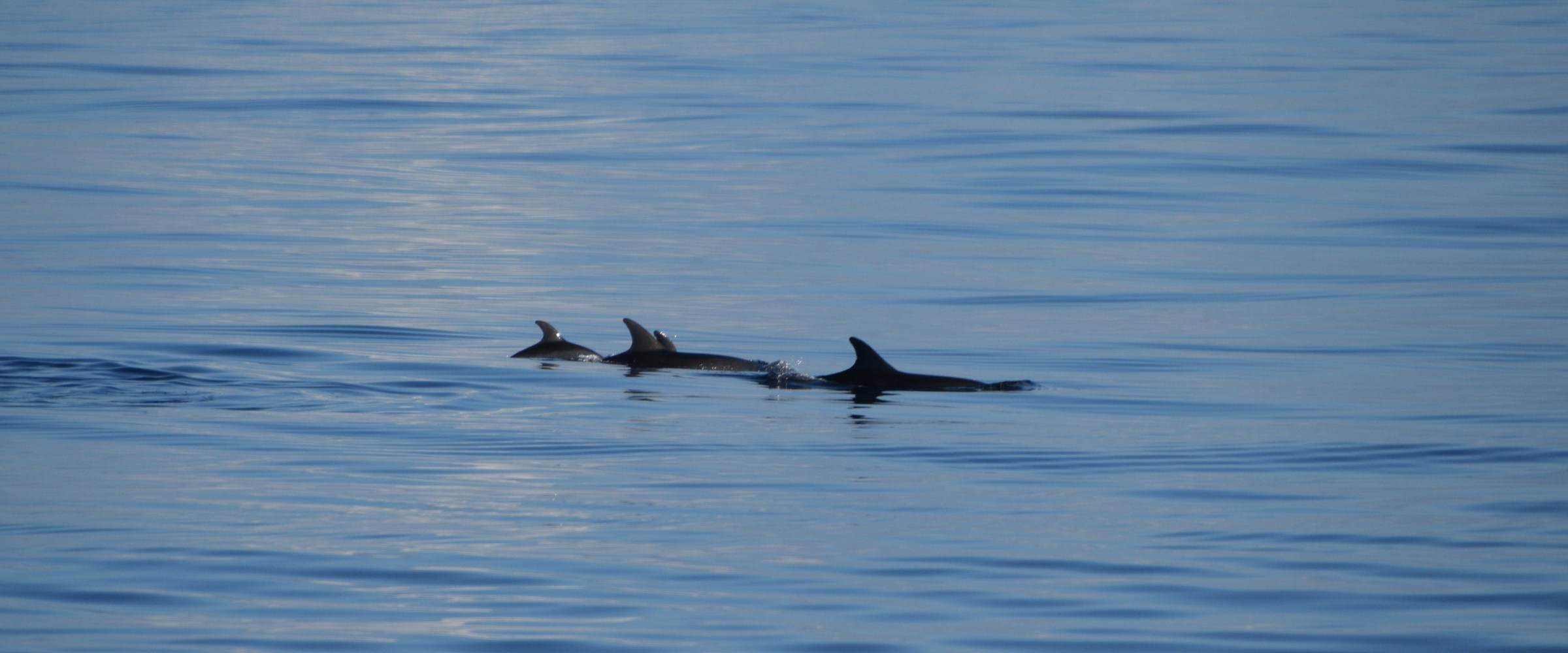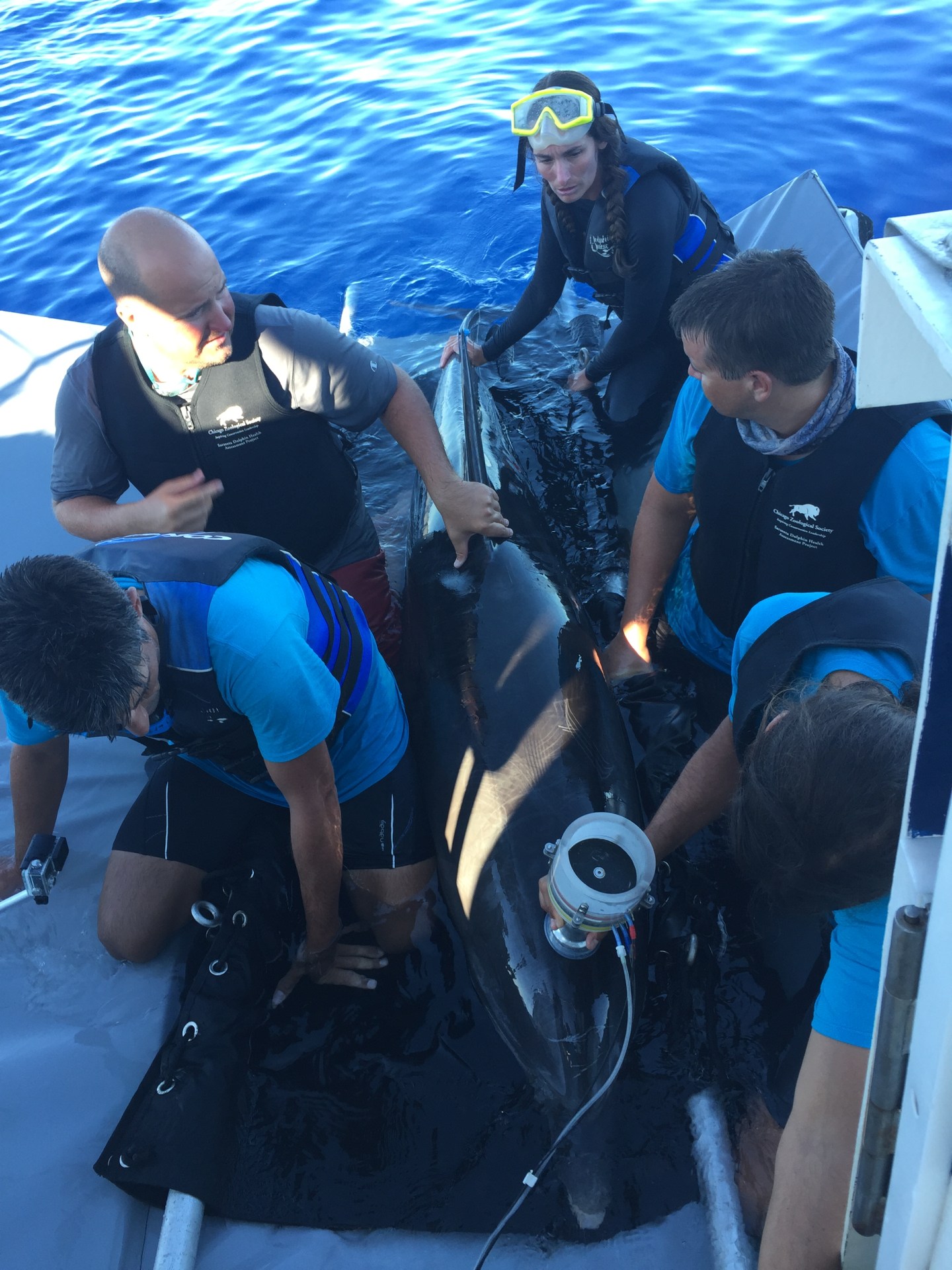THE BERMUDA DOLPHIN CONSERVATION PROJECT AND DOLPHIN TRACKING PROJECT
LOCATION: BERMUDA
|
Randall Wells, PhD; Katherine McHugh, PhD; Jason Allen; Aaron Barleycorn |
Andreas Fahlman, PhD |
|
Jay Sweeney, DVM; Rae Stone, DVM; Robyn Faulkner Allen; Austin Allen, PhD |
Frants Jensen, PhD; Michael Moore, PhD |

PROJECT SUMMARY

The Bermuda Dolphin Conservation Project
Building on data collected during Dolphin Quest’s 2003, 2004, 2005, and 2015 studies, the objective of the 2016 Bermuda wild dolphin health assessment was to investigate a pelagic diving population of bottlenose dolphins Tursiops truncatus in the waters off Bermuda.

The Bermuda Dolphin Conservation Project
During this study, we analyzed the following:
- Health
- Diving and respiratory physiology
- Resting metabolic rate
- Diving and ranging behavior

The Bermuda Dolphin Conservation Project
Additional objectives included sampling for:
- Genetics
- Monitoring reproduction
- Tracking animals over time with individual identification from natural markings

The Bermuda Dolphin Conservation Project
Collecting samples for measuring contaminant levels to compare to dolphins that have been studied on the East Coast of the US, Bermuda, and the Gulf of Mexico.

The Bermuda Dolphin Conservation Project
DOLPHIN TRACKING - 2016
The following data was collected in 2016 from four of Bermuda’s deepwater bottlenose dolphins named, Devonshire, Hamilton, Paget, and Pembroke. The dolphins were fitted with temporary satellite tags as part of an ongoing health assessment by an international team of marine mammal scientists, Dolphin Quest veterinarians, and animal care professionals.
Location Maps (reference for maps pictured in weekly summaries)
The following maps show the locations of each dolphin as determined through the reception by satellites of signals from the dolphin, transmitted upon surfacing.
Large circle – most recent location
Small circle – oldest location
Connecting lines – connect consecutive circles, but do not represent dolphin travel routes
Select a date to view weekly dolphin tracking summary:
-
None of the four tagged dolphins has transmitted since November 8. Hamilton stopped transmitting on November 3, Devonshire on November 4, and the other two on November 8. Battery exhaustion appears to be the cause of transmission cessation for at least three of the four tags. The battery indicator does not appear to have been functioning properly for Paget, as voltage implausibly remained unchanged since August, but like the other three dolphins, her tag made more than 25,000 transmissions. In no cases did the animals cease making deep or long dives prior to the last signals, suggesting electronics rather than animal issues.
Since the last weekly report, Pembroke remained at Plantagenet and Challenger Banks. Paget completed her wide circuit of Bermuda and moved back and forth south of the ridge of seamounts she visited several weeks ago.
Both dolphins transmitting since the last weekly report continued to make deep dives in excess of 400 meters and 7 minutes. Their deepest and longest dives continued to occur in the late afternoon into the night and early morning.
Both overall maximum dive depth and overall maximum dive duration have exceeded previous documented records for Bermuda dolphins. Since tracking began, each dolphin has made dives below 50 meters lasting more than 12 min (up to >13.8 min), and one dove to 1,008 meters – a new record for bottlenose dolphins. As noted previously, the deepest dives did not occur every night, and few occur in a single night.
Unless we begin to get signals again, this will be the last regular report. Efforts will now shift to preparing summary reports and scientific manuscripts based on these novel data.


-
The four tagged dolphins continue to provide good signals, including location and dive data, for most of the week, but Hamilton stopped transmitting on November 3, 2016. His tag battery strength had declined in the most recent tag status message, and there were no significant changes in dive patterns prior to the last signal, so we suspect that the signals ceased due to battery exhaustion.
The three males remained fairly separate this week. Pembroke remained at Plantagenet and Challenger Banks. Hamilton moved from the south side of Bermuda to Challenger Bank before signals ceased. Devonshire remained off the eastern end of Bermuda. Paget completed her wide circuit of Bermuda and is currently south of the ridge of seamounts she visited several weeks ago.
All continued to make deep dives over the past week, in excess of 600 meters and 11 minutes. Their deepest and longest dives continue to occur in the late afternoon into the night and early morning.
Both overall maximum dive depth and overall maximum dive duration have exceeded previous documented records for Bermuda dolphins. Since tracking began, each dolphin has made dives below 50 meters lasting more than 12 minutes (up to >13.8 minutes), and one dove to 1,008 meters – a new record for bottlenose dolphins. As noted previously, the deepest dives do not occur every night, and few occur in a single night.


Locations for Devonshire (yellow), Hamilton (green), and Pembroke (blue) for the October 29 – November 4, 2016.

Locations for Paget for the past 20 days. (Ignore implausible outlier track lines.)
-
The four tagged dolphins continue to provide good signals, including location and dive data. The three males were on the move this week, using the Plantagenet and Challenger Banks as well as circling Bermuda proper. Paget remained several hundred kilometers off Bermuda as she continued her circle around the island. While there are no obvious physical features guiding her circumnavigation, her movements are consistent with the general pattern of surface water circulation in the Sargasso Sea (see map pictured below).
All continued to make deep dives over the past week, in excess of 500 meters and 10 minutes. Their deepest and longest dives continue to occur in the late afternoon into the night and early morning.
Both overall maximum dive depth and overall maximum dive duration have exceeded previous documented records for Bermuda dolphins. Since tracking began, each dolphin has made dives below 50 meters lasting more than 12 minutes (up to >13.8 minutes), and one dove to 1,008 meters – a new record for bottlenose dolphins. As noted previously, the deepest dives do not occur every night, and few occur in a single night.


Locations for Devonshire (yellow), Hamilton (green), and Pembroke (blue) for the October 22-28, 2016.

Locations for Paget for the past 20 days. (Ignore implausible outlier track lines.)

Sargasso Sea surface currents – Map courtesy of MPAtlas
-
The four tagged dolphins continue to provide good signals, including location and dive data. The three males remain mostly in slope waters around the Bermuda Pedestal and associated banks to the west. Pembroke has spent the week at Challenger and Plantagenet Banks and off the west side of Bermuda, while Devonshire and Hamilton were mostly around the eastern half of the island. Paget remained several hundred kilometers off Bermuda as she passed to the east, south, and now southwest of the island. Who knows where she will go next?
All continued to make deep dives over the past week, in excess of 500 meters and ~10 minutes. Their deepest dives continue to occur in the late afternoon into the night. Paget continues to have breaks of one or more days in her dive data record, but given that her documented dives continue to reach depths over 500 meters and 10 minutes, we suspect the missing data might be due to environmental conditions (e.g., rough seas) that are not conducive to allowing long data transmissions.
Both overall maximum dive depth and overall maximum dive duration have exceeded previous documented records for Bermuda dolphins. Since tracking began, each dolphin has made dives below 50 meters lasting more than 12 minutes (up to >13.8 minutes), and one dove to 1,008 meters – a new record for bottlenose dolphins. As noted previously, the deepest dives do not occur every night, and few occur in a single night.


Locations for Devonshire (yellow), Hamilton (green), and Pembroke (blue) for the October 15-21, 2016. (The lines that lead outside of the map frame are implausible locations and should be ignored.)

Locations for Paget for the past 20 days. (Ignore implausible outlier track lines.)
-
The four tagged dolphins continue to provide good signals, including location and dive data. The three males, Devonshire, Hamilton, and Pembroke remain mostly in slope waters around the Bermuda Pedestal and associated banks to the west. Pembroke has spent much of the week at Challenger and Plantagenet Banks, while Devonshire and Hamilton were mostly east of the island. Paget appears to be returning to Bermuda, although not as directly as she headed to the northern seamounts.
There have been a few breaks in dive data sequences for two of the dolphins this week. This may be due to rough seas interfering with transmission of the longer messages containing dive data. All continued to make deep dives over the past week, in excess of 500 meters. Their deepest dives continue to occur in the late afternoon into the night.
Both overall maximum dive depth and overall maximum dive duration have exceeded previous documented records for Bermuda dolphins. Since tracking began, each dolphin has made dives lasting more than 12 minutes (up to >13.8 minutes), and one dove to 1,008 meters – a new record for bottlenose dolphins, to the best of our knowledge. As noted previously, the deepest dives do not occur every night, and few occur in a single night.
The dolphins continue their fission-fusion social pattern. At times, some of them appear to be together, while most of the time over the past week they have been clearly separated.


Locations for Devonshire (yellow), Hamilton (green), and Pembroke (blue) for the October 8-14, 2016. (The lines that lead outside of the map frame are implausible and should be ignored.)

Locations for Paget (Tt0021) for October 8-14, 2016
-
Overall Summary
The four tagged dolphins continue to provide good signals, including location and dive data. Three of them remain mostly in slope waters around the Bermuda Pedestal and associated banks to the west, but one has left Bermuda for points north. Pembroke has spent much of the week to the west and south of Bermuda including the banks to the SW. Devonshire has been primarily to the north and east of Bermuda (the line across the island is an artifact of timing of location data, not the real path). Hamilton has been mostly north and east of Bermuda (again, ignore the lines across the island), although most recently he was south.
Paget has spent the past few days heading steadily north, a pattern we have not seen previously with dolphins tagged in Bermuda. She is currently about 420 kilometers north of the island. These movements really beg the question of how we will eventually define “population(s)” for bottlenose dolphins in the mid-Atlantic.
All continued to make deep dives over the past week, in excess of 500 meters. Their deepest dives continue to occur in the late afternoon into the night. Both overall maximum dive depth and overall maximum dive duration have exceeded previous documented records for Bermuda dolphins. Each dolphin has made dives lasting more than 12 minutes (up to >13.8 minutes), and one dove to 1,008 meters – a new record for bottlenose dolphins, to the best of our knowledge. As noted previously, the deepest dives do not occur every night, and few occur in a single night. The dolphins continue their fission-fusion social pattern. At times, some of them appear to be together, while most of the time over the past week they have been clearly separated.

-
Overall Summary
The four tagged dolphins continue to provide good signals, including location and dive data. They remain mostly in slope waters around the Bermuda Pedestal and associated banks to the west, with two dolphins venturing out as far as Plantangenet Bank. Pembroke has spent much of the week to the west of Bermuda including the banks to the SW. Devonshire has been primarily to the north and west of Bermuda. Hamilton, except for a brief foray to Plantangenet Bank, has been mostly north and east of Bermuda, and Paget’s movements have been concentrated to the NE of Bermuda. Their deepest dives have been occurring in the late afternoon into the night. Both maximum dive depth and maximum dive duration have exceeded previous documented records for Bermuda dolphins. To date, each dolphin has made dives lasting more than 12 minutes (up to >13.8 minutes), and over the past week, Hamilton dove to 1,008 meters – a new record for bottlenose dolphins, to the best of our knowledge. As noted previously, the deepest dives do not occur every night, and few occur in a single night. Preliminary analyses by Frants Jensen show good concordance between dive data from his DTAGs and dive data from the long-term SPLASH tags we are currently tracking. The dolphins continue their fission-fusion social pattern. At times, some or all of them appear to be together, while most of the time over the past week they have been clearly separated.

-
Overall Summary
The four tagged dolphins continue to provide good signals, including location and dive data. So far, they have remained in slope waters around the Bermuda Pedestal and associated banks to the west. All of them ventured to Challenger Bank to the SW during the tracking period; only Pembroke has remained there. Their deepest dives have been occurring in the evening and especially at night. Both maximum dive depth and maximum dive duration have exceeded previous documented records for Bermuda dolphins. To date, each dolphin has made dives lasting more than 12 minutes, and one has made a dive deeper than 900 meters. It should be noted that the deepest dives do not occur every night and few occur in a single night. The deepest dives are not necessarily those of longest duration. To date, each of the dolphins has made their deepest dives on different nights. The dolphins are exhibiting a fission-fusion social pattern. At times, some or all of them appear to be together, while at other times they are clearly separated, at different locations.





